Examining Critical Challenges for Big Oil Companies
VerifiedAdded on 2020/01/15
|10
|3539
|68
Essay
AI Summary
This essay provides an overview of the challenges facing Big Oil companies, also known as supermajors, in the oil and gas industry. It examines three major challenges: cash crunch due to declining oil prices, the need to abandon production maximizing policies, and the imperative to plan for a low-carbon global world. The essay discusses the impact of these challenges on company finances, production strategies, and environmental sustainability, providing examples of how companies are responding, such as dividend cuts, cost-cutting measures, and efforts to improve energy efficiency and adopt renewable energy sources. The analysis includes the impact of oil spills, government regulations, and the shift towards sustainable energy practices. The essay highlights the importance of strategic decision-making for the long-term survival and success of oil and gas companies in a changing global environment.
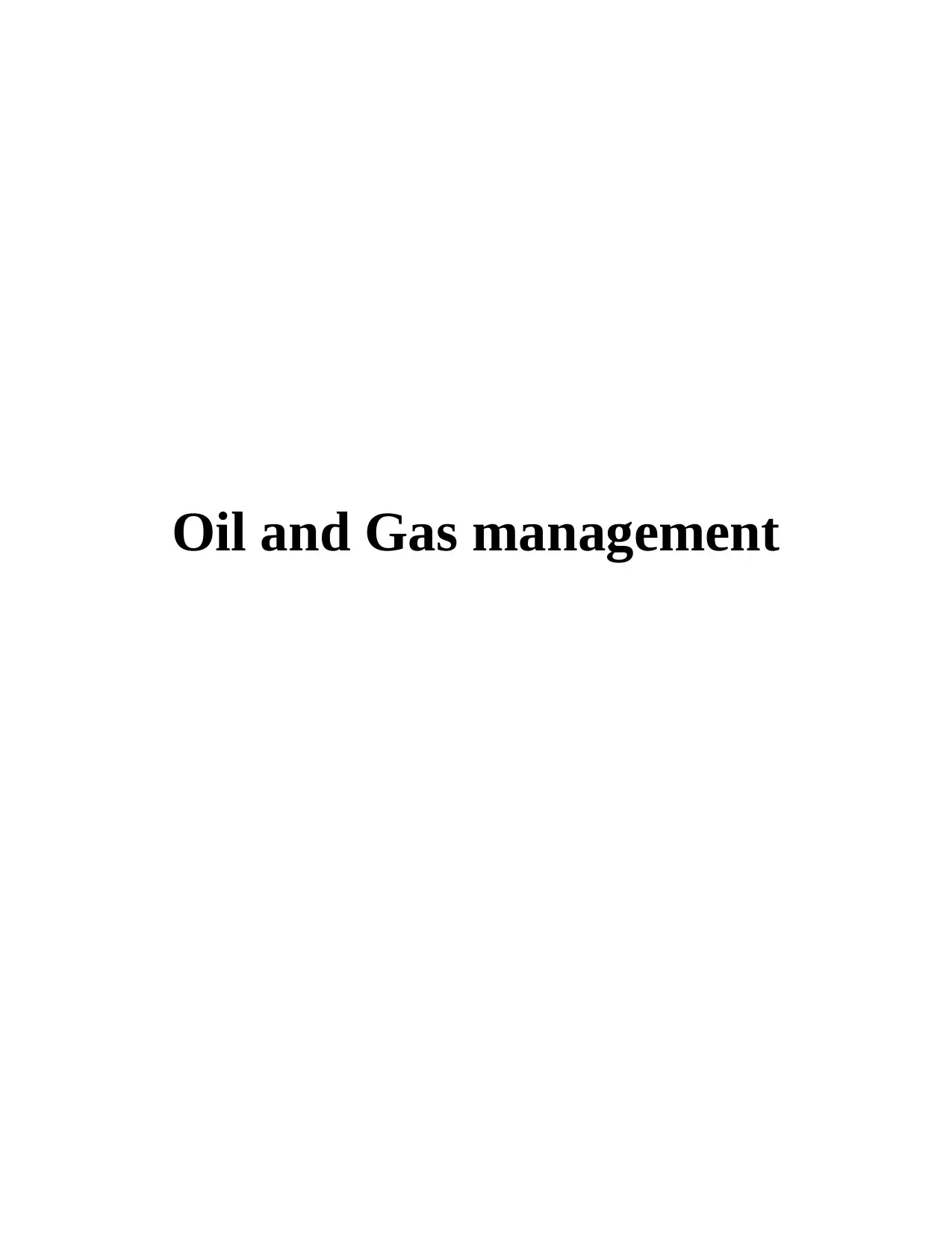
Oil and Gas management
Paraphrase This Document
Need a fresh take? Get an instant paraphrase of this document with our AI Paraphraser
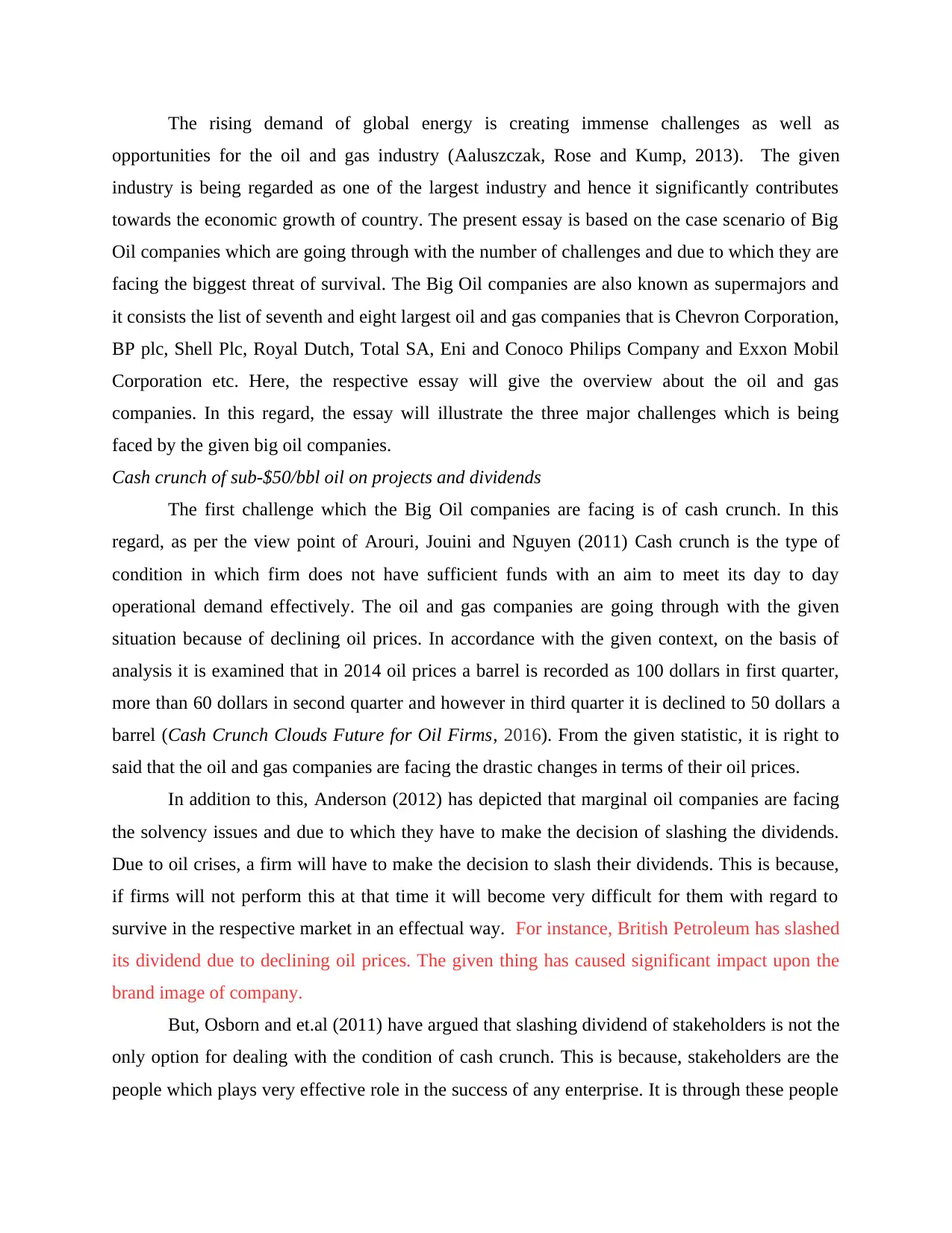
The rising demand of global energy is creating immense challenges as well as
opportunities for the oil and gas industry (Aaluszczak, Rose and Kump, 2013). The given
industry is being regarded as one of the largest industry and hence it significantly contributes
towards the economic growth of country. The present essay is based on the case scenario of Big
Oil companies which are going through with the number of challenges and due to which they are
facing the biggest threat of survival. The Big Oil companies are also known as supermajors and
it consists the list of seventh and eight largest oil and gas companies that is Chevron Corporation,
BP plc, Shell Plc, Royal Dutch, Total SA, Eni and Conoco Philips Company and Exxon Mobil
Corporation etc. Here, the respective essay will give the overview about the oil and gas
companies. In this regard, the essay will illustrate the three major challenges which is being
faced by the given big oil companies.
Cash crunch of sub-$50/bbl oil on projects and dividends
The first challenge which the Big Oil companies are facing is of cash crunch. In this
regard, as per the view point of Arouri, Jouini and Nguyen (2011) Cash crunch is the type of
condition in which firm does not have sufficient funds with an aim to meet its day to day
operational demand effectively. The oil and gas companies are going through with the given
situation because of declining oil prices. In accordance with the given context, on the basis of
analysis it is examined that in 2014 oil prices a barrel is recorded as 100 dollars in first quarter,
more than 60 dollars in second quarter and however in third quarter it is declined to 50 dollars a
barrel (Cash Crunch Clouds Future for Oil Firms, 2016). From the given statistic, it is right to
said that the oil and gas companies are facing the drastic changes in terms of their oil prices.
In addition to this, Anderson (2012) has depicted that marginal oil companies are facing
the solvency issues and due to which they have to make the decision of slashing the dividends.
Due to oil crises, a firm will have to make the decision to slash their dividends. This is because,
if firms will not perform this at that time it will become very difficult for them with regard to
survive in the respective market in an effectual way. For instance, British Petroleum has slashed
its dividend due to declining oil prices. The given thing has caused significant impact upon the
brand image of company.
But, Osborn and et.al (2011) have argued that slashing dividend of stakeholders is not the
only option for dealing with the condition of cash crunch. This is because, stakeholders are the
people which plays very effective role in the success of any enterprise. It is through these people
opportunities for the oil and gas industry (Aaluszczak, Rose and Kump, 2013). The given
industry is being regarded as one of the largest industry and hence it significantly contributes
towards the economic growth of country. The present essay is based on the case scenario of Big
Oil companies which are going through with the number of challenges and due to which they are
facing the biggest threat of survival. The Big Oil companies are also known as supermajors and
it consists the list of seventh and eight largest oil and gas companies that is Chevron Corporation,
BP plc, Shell Plc, Royal Dutch, Total SA, Eni and Conoco Philips Company and Exxon Mobil
Corporation etc. Here, the respective essay will give the overview about the oil and gas
companies. In this regard, the essay will illustrate the three major challenges which is being
faced by the given big oil companies.
Cash crunch of sub-$50/bbl oil on projects and dividends
The first challenge which the Big Oil companies are facing is of cash crunch. In this
regard, as per the view point of Arouri, Jouini and Nguyen (2011) Cash crunch is the type of
condition in which firm does not have sufficient funds with an aim to meet its day to day
operational demand effectively. The oil and gas companies are going through with the given
situation because of declining oil prices. In accordance with the given context, on the basis of
analysis it is examined that in 2014 oil prices a barrel is recorded as 100 dollars in first quarter,
more than 60 dollars in second quarter and however in third quarter it is declined to 50 dollars a
barrel (Cash Crunch Clouds Future for Oil Firms, 2016). From the given statistic, it is right to
said that the oil and gas companies are facing the drastic changes in terms of their oil prices.
In addition to this, Anderson (2012) has depicted that marginal oil companies are facing
the solvency issues and due to which they have to make the decision of slashing the dividends.
Due to oil crises, a firm will have to make the decision to slash their dividends. This is because,
if firms will not perform this at that time it will become very difficult for them with regard to
survive in the respective market in an effectual way. For instance, British Petroleum has slashed
its dividend due to declining oil prices. The given thing has caused significant impact upon the
brand image of company.
But, Osborn and et.al (2011) have argued that slashing dividend of stakeholders is not the
only option for dealing with the condition of cash crunch. This is because, stakeholders are the
people which plays very effective role in the success of any enterprise. It is through these people
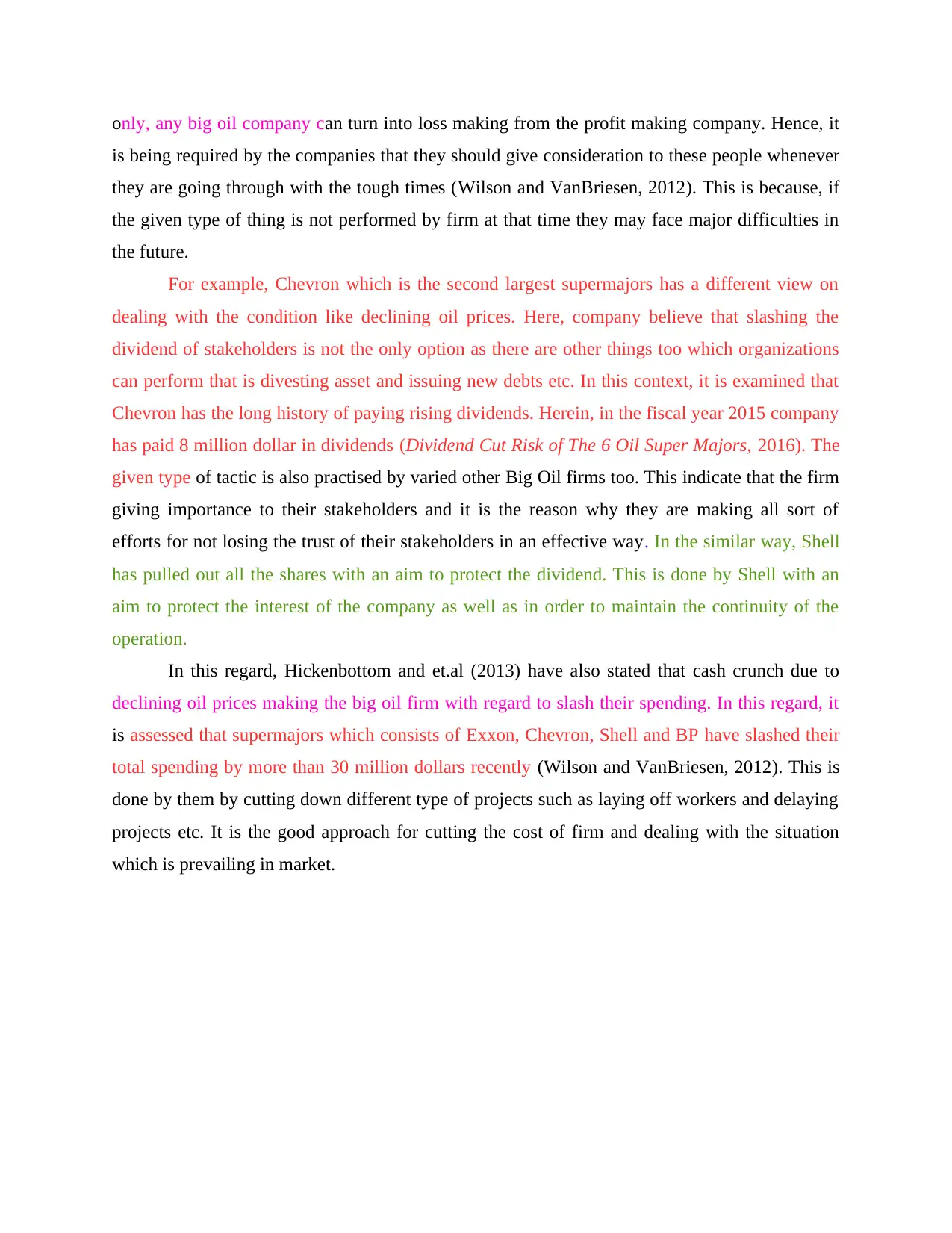
only, any big oil company can turn into loss making from the profit making company. Hence, it
is being required by the companies that they should give consideration to these people whenever
they are going through with the tough times (Wilson and VanBriesen, 2012). This is because, if
the given type of thing is not performed by firm at that time they may face major difficulties in
the future.
For example, Chevron which is the second largest supermajors has a different view on
dealing with the condition like declining oil prices. Here, company believe that slashing the
dividend of stakeholders is not the only option as there are other things too which organizations
can perform that is divesting asset and issuing new debts etc. In this context, it is examined that
Chevron has the long history of paying rising dividends. Herein, in the fiscal year 2015 company
has paid 8 million dollar in dividends (Dividend Cut Risk of The 6 Oil Super Majors, 2016). The
given type of tactic is also practised by varied other Big Oil firms too. This indicate that the firm
giving importance to their stakeholders and it is the reason why they are making all sort of
efforts for not losing the trust of their stakeholders in an effective way. In the similar way, Shell
has pulled out all the shares with an aim to protect the dividend. This is done by Shell with an
aim to protect the interest of the company as well as in order to maintain the continuity of the
operation.
In this regard, Hickenbottom and et.al (2013) have also stated that cash crunch due to
declining oil prices making the big oil firm with regard to slash their spending. In this regard, it
is assessed that supermajors which consists of Exxon, Chevron, Shell and BP have slashed their
total spending by more than 30 million dollars recently (Wilson and VanBriesen, 2012). This is
done by them by cutting down different type of projects such as laying off workers and delaying
projects etc. It is the good approach for cutting the cost of firm and dealing with the situation
which is prevailing in market.
is being required by the companies that they should give consideration to these people whenever
they are going through with the tough times (Wilson and VanBriesen, 2012). This is because, if
the given type of thing is not performed by firm at that time they may face major difficulties in
the future.
For example, Chevron which is the second largest supermajors has a different view on
dealing with the condition like declining oil prices. Here, company believe that slashing the
dividend of stakeholders is not the only option as there are other things too which organizations
can perform that is divesting asset and issuing new debts etc. In this context, it is examined that
Chevron has the long history of paying rising dividends. Herein, in the fiscal year 2015 company
has paid 8 million dollar in dividends (Dividend Cut Risk of The 6 Oil Super Majors, 2016). The
given type of tactic is also practised by varied other Big Oil firms too. This indicate that the firm
giving importance to their stakeholders and it is the reason why they are making all sort of
efforts for not losing the trust of their stakeholders in an effective way. In the similar way, Shell
has pulled out all the shares with an aim to protect the dividend. This is done by Shell with an
aim to protect the interest of the company as well as in order to maintain the continuity of the
operation.
In this regard, Hickenbottom and et.al (2013) have also stated that cash crunch due to
declining oil prices making the big oil firm with regard to slash their spending. In this regard, it
is assessed that supermajors which consists of Exxon, Chevron, Shell and BP have slashed their
total spending by more than 30 million dollars recently (Wilson and VanBriesen, 2012). This is
done by them by cutting down different type of projects such as laying off workers and delaying
projects etc. It is the good approach for cutting the cost of firm and dealing with the situation
which is prevailing in market.
⊘ This is a preview!⊘
Do you want full access?
Subscribe today to unlock all pages.

Trusted by 1+ million students worldwide
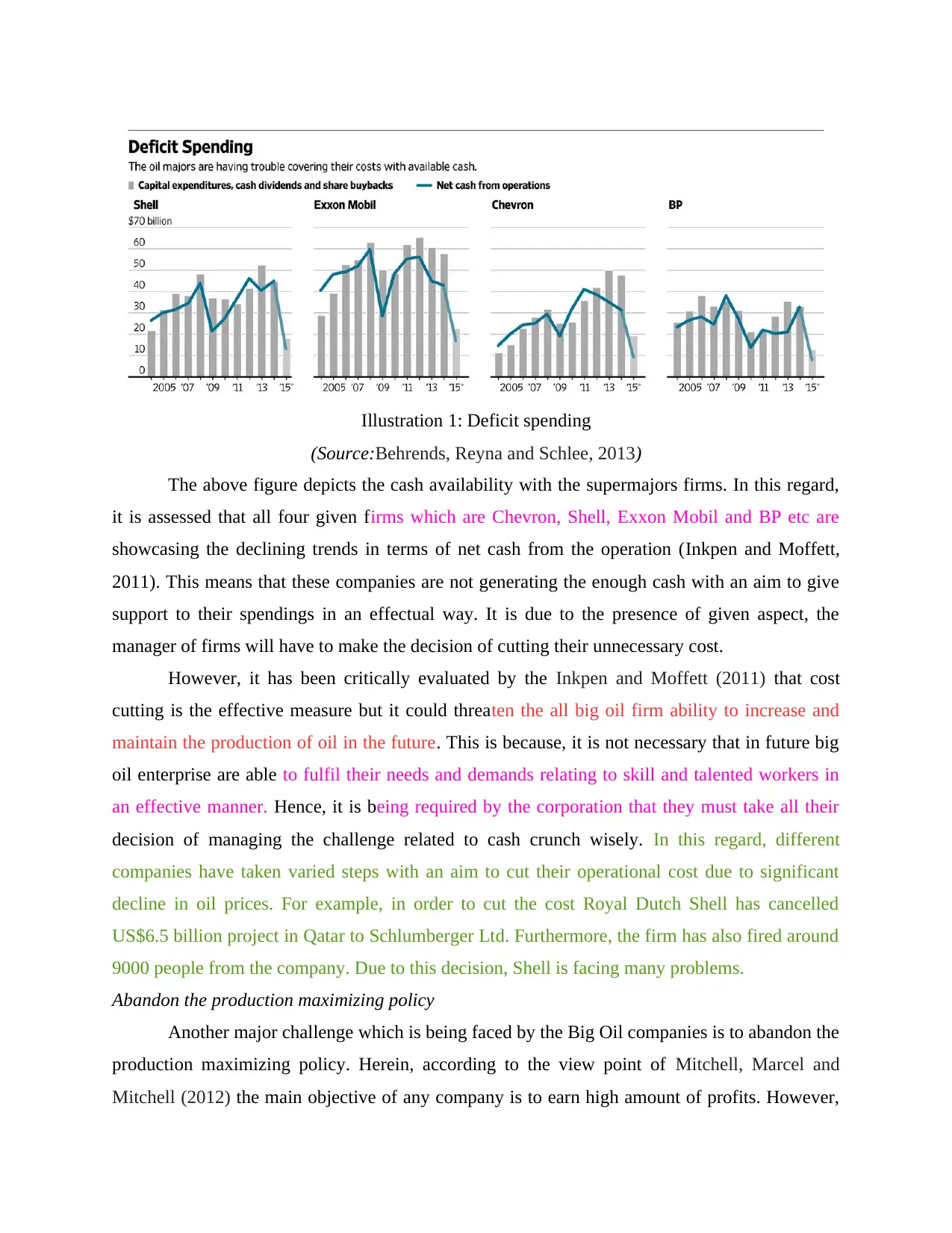
The above figure depicts the cash availability with the supermajors firms. In this regard,
it is assessed that all four given firms which are Chevron, Shell, Exxon Mobil and BP etc are
showcasing the declining trends in terms of net cash from the operation (Inkpen and Moffett,
2011). This means that these companies are not generating the enough cash with an aim to give
support to their spendings in an effectual way. It is due to the presence of given aspect, the
manager of firms will have to make the decision of cutting their unnecessary cost.
However, it has been critically evaluated by the Inkpen and Moffett (2011) that cost
cutting is the effective measure but it could threaten the all big oil firm ability to increase and
maintain the production of oil in the future. This is because, it is not necessary that in future big
oil enterprise are able to fulfil their needs and demands relating to skill and talented workers in
an effective manner. Hence, it is being required by the corporation that they must take all their
decision of managing the challenge related to cash crunch wisely. In this regard, different
companies have taken varied steps with an aim to cut their operational cost due to significant
decline in oil prices. For example, in order to cut the cost Royal Dutch Shell has cancelled
US$6.5 billion project in Qatar to Schlumberger Ltd. Furthermore, the firm has also fired around
9000 people from the company. Due to this decision, Shell is facing many problems.
Abandon the production maximizing policy
Another major challenge which is being faced by the Big Oil companies is to abandon the
production maximizing policy. Herein, according to the view point of Mitchell, Marcel and
Mitchell (2012) the main objective of any company is to earn high amount of profits. However,
Illustration 1: Deficit spending
(Source:Behrends, Reyna and Schlee, 2013)
it is assessed that all four given firms which are Chevron, Shell, Exxon Mobil and BP etc are
showcasing the declining trends in terms of net cash from the operation (Inkpen and Moffett,
2011). This means that these companies are not generating the enough cash with an aim to give
support to their spendings in an effectual way. It is due to the presence of given aspect, the
manager of firms will have to make the decision of cutting their unnecessary cost.
However, it has been critically evaluated by the Inkpen and Moffett (2011) that cost
cutting is the effective measure but it could threaten the all big oil firm ability to increase and
maintain the production of oil in the future. This is because, it is not necessary that in future big
oil enterprise are able to fulfil their needs and demands relating to skill and talented workers in
an effective manner. Hence, it is being required by the corporation that they must take all their
decision of managing the challenge related to cash crunch wisely. In this regard, different
companies have taken varied steps with an aim to cut their operational cost due to significant
decline in oil prices. For example, in order to cut the cost Royal Dutch Shell has cancelled
US$6.5 billion project in Qatar to Schlumberger Ltd. Furthermore, the firm has also fired around
9000 people from the company. Due to this decision, Shell is facing many problems.
Abandon the production maximizing policy
Another major challenge which is being faced by the Big Oil companies is to abandon the
production maximizing policy. Herein, according to the view point of Mitchell, Marcel and
Mitchell (2012) the main objective of any company is to earn high amount of profits. However,
Illustration 1: Deficit spending
(Source:Behrends, Reyna and Schlee, 2013)
Paraphrase This Document
Need a fresh take? Get an instant paraphrase of this document with our AI Paraphraser
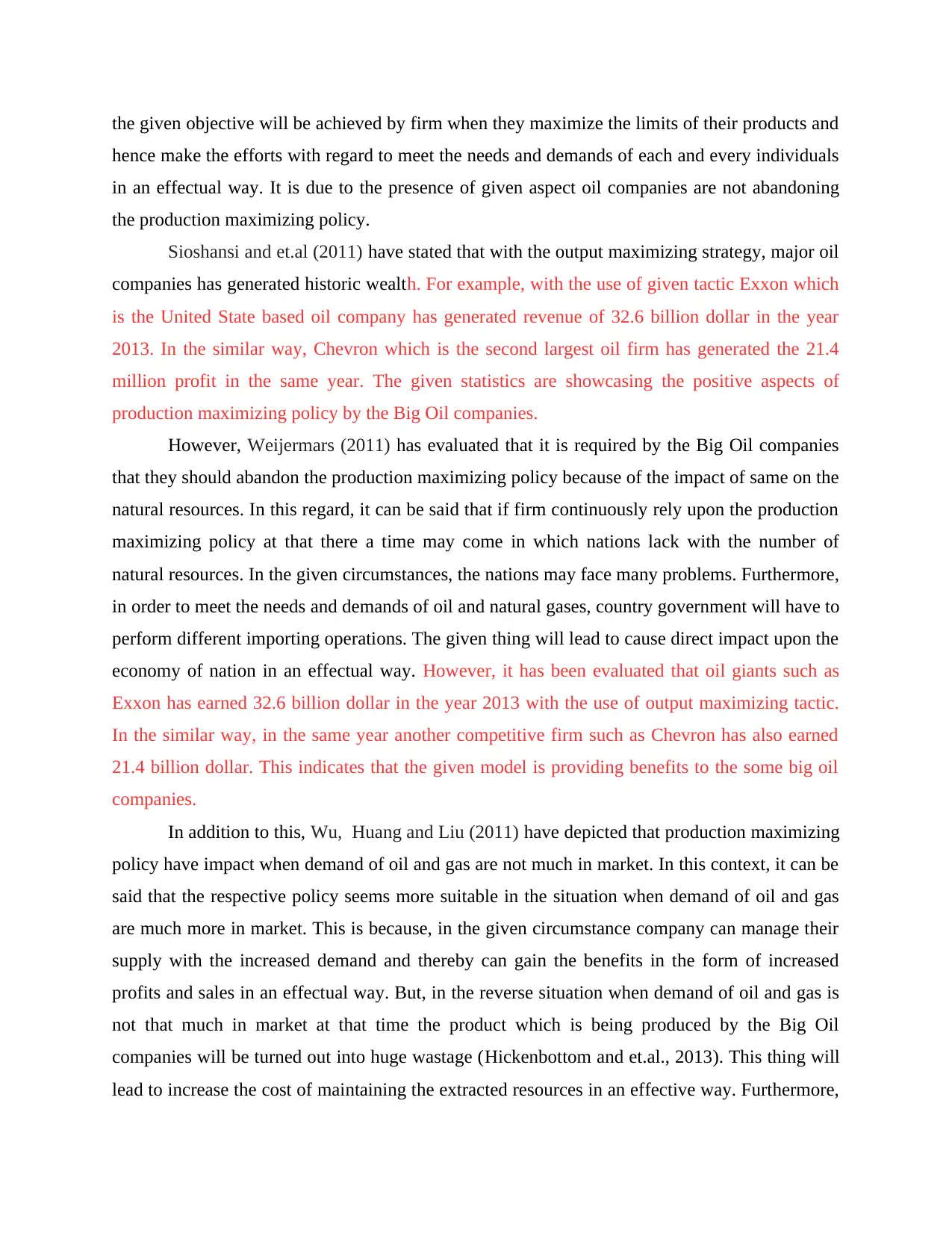
the given objective will be achieved by firm when they maximize the limits of their products and
hence make the efforts with regard to meet the needs and demands of each and every individuals
in an effectual way. It is due to the presence of given aspect oil companies are not abandoning
the production maximizing policy.
Sioshansi and et.al (2011) have stated that with the output maximizing strategy, major oil
companies has generated historic wealth. For example, with the use of given tactic Exxon which
is the United State based oil company has generated revenue of 32.6 billion dollar in the year
2013. In the similar way, Chevron which is the second largest oil firm has generated the 21.4
million profit in the same year. The given statistics are showcasing the positive aspects of
production maximizing policy by the Big Oil companies.
However, Weijermars (2011) has evaluated that it is required by the Big Oil companies
that they should abandon the production maximizing policy because of the impact of same on the
natural resources. In this regard, it can be said that if firm continuously rely upon the production
maximizing policy at that there a time may come in which nations lack with the number of
natural resources. In the given circumstances, the nations may face many problems. Furthermore,
in order to meet the needs and demands of oil and natural gases, country government will have to
perform different importing operations. The given thing will lead to cause direct impact upon the
economy of nation in an effectual way. However, it has been evaluated that oil giants such as
Exxon has earned 32.6 billion dollar in the year 2013 with the use of output maximizing tactic.
In the similar way, in the same year another competitive firm such as Chevron has also earned
21.4 billion dollar. This indicates that the given model is providing benefits to the some big oil
companies.
In addition to this, Wu, Huang and Liu (2011) have depicted that production maximizing
policy have impact when demand of oil and gas are not much in market. In this context, it can be
said that the respective policy seems more suitable in the situation when demand of oil and gas
are much more in market. This is because, in the given circumstance company can manage their
supply with the increased demand and thereby can gain the benefits in the form of increased
profits and sales in an effectual way. But, in the reverse situation when demand of oil and gas is
not that much in market at that time the product which is being produced by the Big Oil
companies will be turned out into huge wastage (Hickenbottom and et.al., 2013). This thing will
lead to increase the cost of maintaining the extracted resources in an effective way. Furthermore,
hence make the efforts with regard to meet the needs and demands of each and every individuals
in an effectual way. It is due to the presence of given aspect oil companies are not abandoning
the production maximizing policy.
Sioshansi and et.al (2011) have stated that with the output maximizing strategy, major oil
companies has generated historic wealth. For example, with the use of given tactic Exxon which
is the United State based oil company has generated revenue of 32.6 billion dollar in the year
2013. In the similar way, Chevron which is the second largest oil firm has generated the 21.4
million profit in the same year. The given statistics are showcasing the positive aspects of
production maximizing policy by the Big Oil companies.
However, Weijermars (2011) has evaluated that it is required by the Big Oil companies
that they should abandon the production maximizing policy because of the impact of same on the
natural resources. In this regard, it can be said that if firm continuously rely upon the production
maximizing policy at that there a time may come in which nations lack with the number of
natural resources. In the given circumstances, the nations may face many problems. Furthermore,
in order to meet the needs and demands of oil and natural gases, country government will have to
perform different importing operations. The given thing will lead to cause direct impact upon the
economy of nation in an effectual way. However, it has been evaluated that oil giants such as
Exxon has earned 32.6 billion dollar in the year 2013 with the use of output maximizing tactic.
In the similar way, in the same year another competitive firm such as Chevron has also earned
21.4 billion dollar. This indicates that the given model is providing benefits to the some big oil
companies.
In addition to this, Wu, Huang and Liu (2011) have depicted that production maximizing
policy have impact when demand of oil and gas are not much in market. In this context, it can be
said that the respective policy seems more suitable in the situation when demand of oil and gas
are much more in market. This is because, in the given circumstance company can manage their
supply with the increased demand and thereby can gain the benefits in the form of increased
profits and sales in an effectual way. But, in the reverse situation when demand of oil and gas is
not that much in market at that time the product which is being produced by the Big Oil
companies will be turned out into huge wastage (Hickenbottom and et.al., 2013). This thing will
lead to increase the cost of maintaining the extracted resources in an effective way. Furthermore,
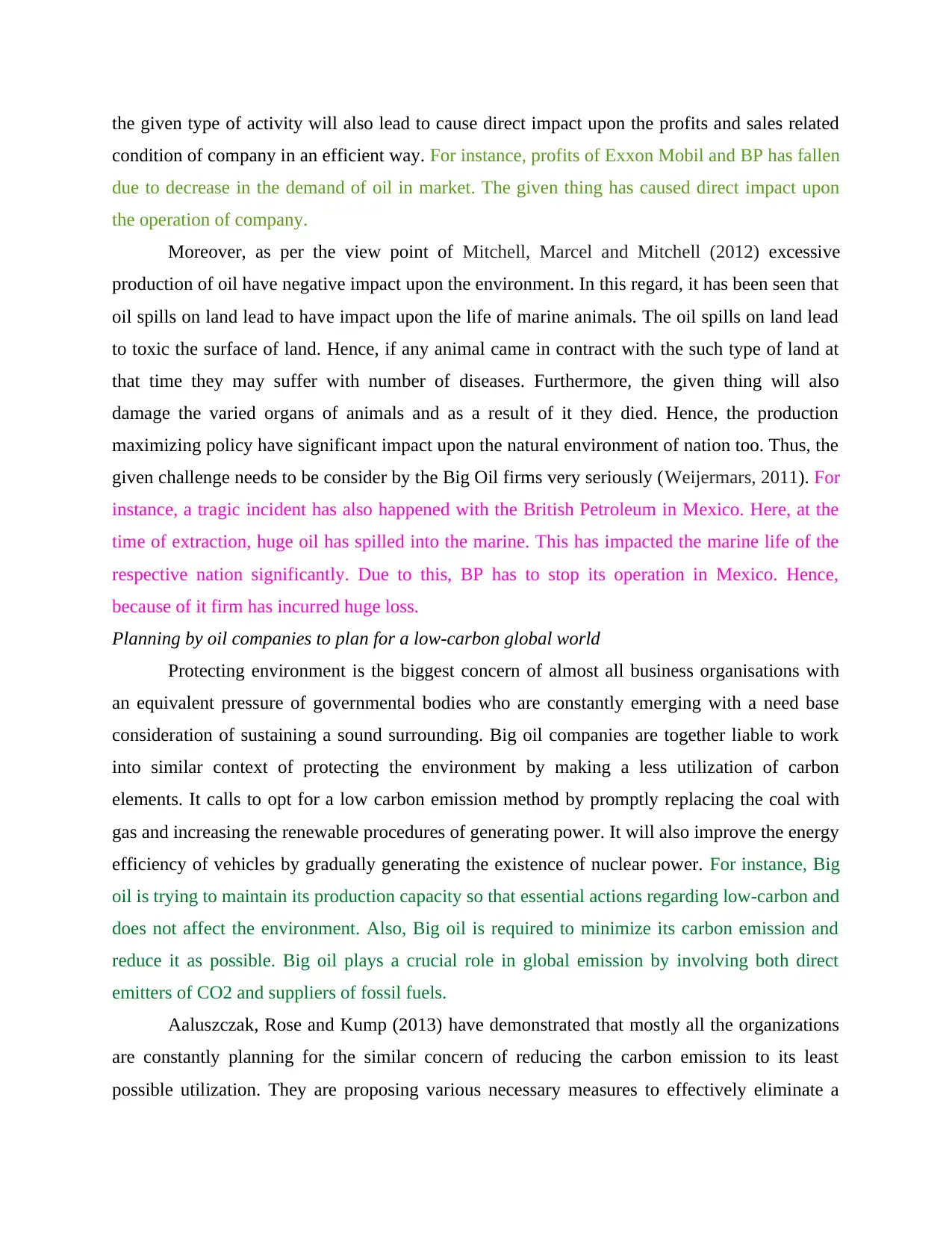
the given type of activity will also lead to cause direct impact upon the profits and sales related
condition of company in an efficient way. For instance, profits of Exxon Mobil and BP has fallen
due to decrease in the demand of oil in market. The given thing has caused direct impact upon
the operation of company.
Moreover, as per the view point of Mitchell, Marcel and Mitchell (2012) excessive
production of oil have negative impact upon the environment. In this regard, it has been seen that
oil spills on land lead to have impact upon the life of marine animals. The oil spills on land lead
to toxic the surface of land. Hence, if any animal came in contract with the such type of land at
that time they may suffer with number of diseases. Furthermore, the given thing will also
damage the varied organs of animals and as a result of it they died. Hence, the production
maximizing policy have significant impact upon the natural environment of nation too. Thus, the
given challenge needs to be consider by the Big Oil firms very seriously (Weijermars, 2011). For
instance, a tragic incident has also happened with the British Petroleum in Mexico. Here, at the
time of extraction, huge oil has spilled into the marine. This has impacted the marine life of the
respective nation significantly. Due to this, BP has to stop its operation in Mexico. Hence,
because of it firm has incurred huge loss.
Planning by oil companies to plan for a low-carbon global world
Protecting environment is the biggest concern of almost all business organisations with
an equivalent pressure of governmental bodies who are constantly emerging with a need base
consideration of sustaining a sound surrounding. Big oil companies are together liable to work
into similar context of protecting the environment by making a less utilization of carbon
elements. It calls to opt for a low carbon emission method by promptly replacing the coal with
gas and increasing the renewable procedures of generating power. It will also improve the energy
efficiency of vehicles by gradually generating the existence of nuclear power. For instance, Big
oil is trying to maintain its production capacity so that essential actions regarding low-carbon and
does not affect the environment. Also, Big oil is required to minimize its carbon emission and
reduce it as possible. Big oil plays a crucial role in global emission by involving both direct
emitters of CO2 and suppliers of fossil fuels.
Aaluszczak, Rose and Kump (2013) have demonstrated that mostly all the organizations
are constantly planning for the similar concern of reducing the carbon emission to its least
possible utilization. They are proposing various necessary measures to effectively eliminate a
condition of company in an efficient way. For instance, profits of Exxon Mobil and BP has fallen
due to decrease in the demand of oil in market. The given thing has caused direct impact upon
the operation of company.
Moreover, as per the view point of Mitchell, Marcel and Mitchell (2012) excessive
production of oil have negative impact upon the environment. In this regard, it has been seen that
oil spills on land lead to have impact upon the life of marine animals. The oil spills on land lead
to toxic the surface of land. Hence, if any animal came in contract with the such type of land at
that time they may suffer with number of diseases. Furthermore, the given thing will also
damage the varied organs of animals and as a result of it they died. Hence, the production
maximizing policy have significant impact upon the natural environment of nation too. Thus, the
given challenge needs to be consider by the Big Oil firms very seriously (Weijermars, 2011). For
instance, a tragic incident has also happened with the British Petroleum in Mexico. Here, at the
time of extraction, huge oil has spilled into the marine. This has impacted the marine life of the
respective nation significantly. Due to this, BP has to stop its operation in Mexico. Hence,
because of it firm has incurred huge loss.
Planning by oil companies to plan for a low-carbon global world
Protecting environment is the biggest concern of almost all business organisations with
an equivalent pressure of governmental bodies who are constantly emerging with a need base
consideration of sustaining a sound surrounding. Big oil companies are together liable to work
into similar context of protecting the environment by making a less utilization of carbon
elements. It calls to opt for a low carbon emission method by promptly replacing the coal with
gas and increasing the renewable procedures of generating power. It will also improve the energy
efficiency of vehicles by gradually generating the existence of nuclear power. For instance, Big
oil is trying to maintain its production capacity so that essential actions regarding low-carbon and
does not affect the environment. Also, Big oil is required to minimize its carbon emission and
reduce it as possible. Big oil plays a crucial role in global emission by involving both direct
emitters of CO2 and suppliers of fossil fuels.
Aaluszczak, Rose and Kump (2013) have demonstrated that mostly all the organizations
are constantly planning for the similar concern of reducing the carbon emission to its least
possible utilization. They are proposing various necessary measures to effectively eliminate a
⊘ This is a preview!⊘
Do you want full access?
Subscribe today to unlock all pages.

Trusted by 1+ million students worldwide
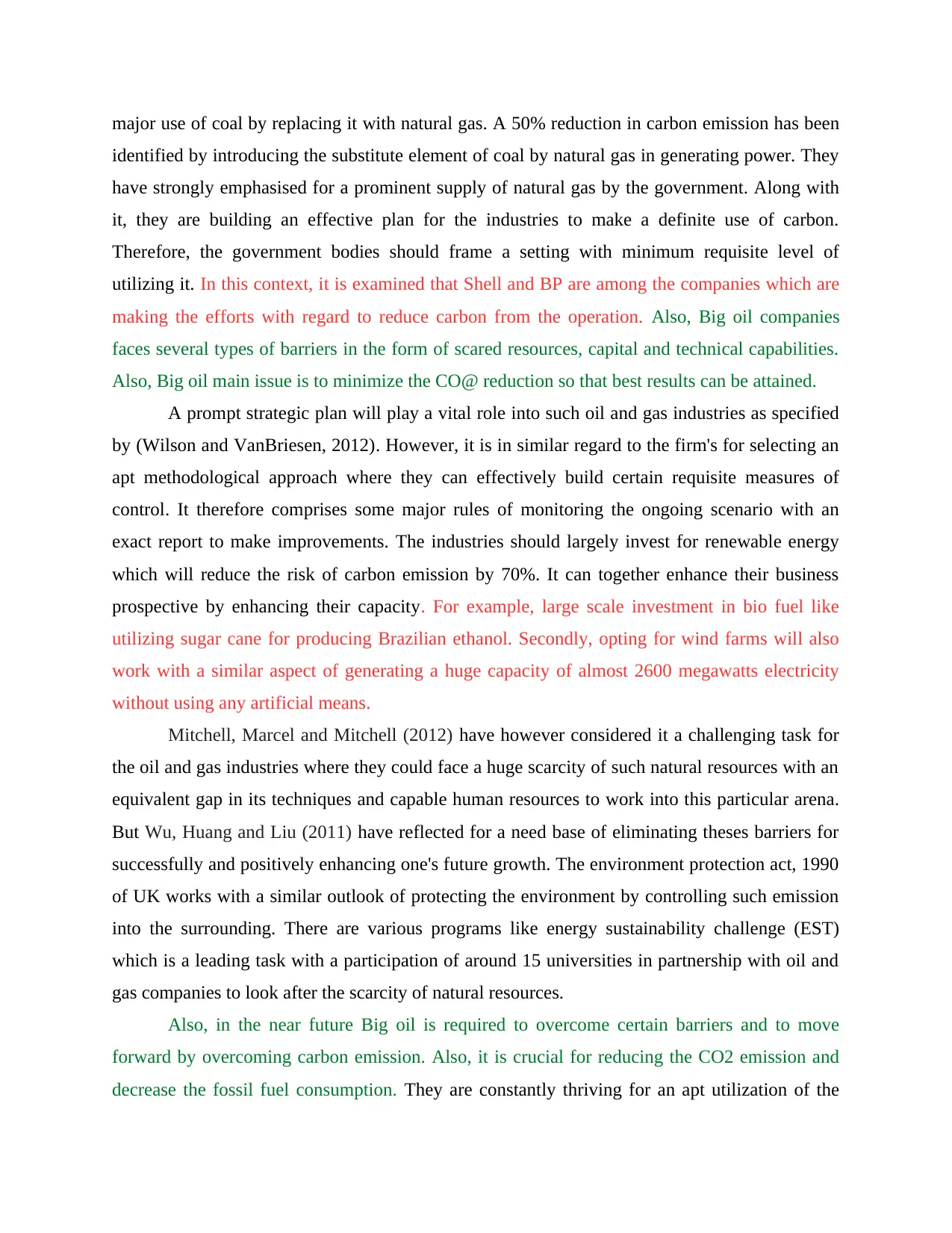
major use of coal by replacing it with natural gas. A 50% reduction in carbon emission has been
identified by introducing the substitute element of coal by natural gas in generating power. They
have strongly emphasised for a prominent supply of natural gas by the government. Along with
it, they are building an effective plan for the industries to make a definite use of carbon.
Therefore, the government bodies should frame a setting with minimum requisite level of
utilizing it. In this context, it is examined that Shell and BP are among the companies which are
making the efforts with regard to reduce carbon from the operation. Also, Big oil companies
faces several types of barriers in the form of scared resources, capital and technical capabilities.
Also, Big oil main issue is to minimize the CO@ reduction so that best results can be attained.
A prompt strategic plan will play a vital role into such oil and gas industries as specified
by (Wilson and VanBriesen, 2012). However, it is in similar regard to the firm's for selecting an
apt methodological approach where they can effectively build certain requisite measures of
control. It therefore comprises some major rules of monitoring the ongoing scenario with an
exact report to make improvements. The industries should largely invest for renewable energy
which will reduce the risk of carbon emission by 70%. It can together enhance their business
prospective by enhancing their capacity. For example, large scale investment in bio fuel like
utilizing sugar cane for producing Brazilian ethanol. Secondly, opting for wind farms will also
work with a similar aspect of generating a huge capacity of almost 2600 megawatts electricity
without using any artificial means.
Mitchell, Marcel and Mitchell (2012) have however considered it a challenging task for
the oil and gas industries where they could face a huge scarcity of such natural resources with an
equivalent gap in its techniques and capable human resources to work into this particular arena.
But Wu, Huang and Liu (2011) have reflected for a need base of eliminating theses barriers for
successfully and positively enhancing one's future growth. The environment protection act, 1990
of UK works with a similar outlook of protecting the environment by controlling such emission
into the surrounding. There are various programs like energy sustainability challenge (EST)
which is a leading task with a participation of around 15 universities in partnership with oil and
gas companies to look after the scarcity of natural resources.
Also, in the near future Big oil is required to overcome certain barriers and to move
forward by overcoming carbon emission. Also, it is crucial for reducing the CO2 emission and
decrease the fossil fuel consumption. They are constantly thriving for an apt utilization of the
identified by introducing the substitute element of coal by natural gas in generating power. They
have strongly emphasised for a prominent supply of natural gas by the government. Along with
it, they are building an effective plan for the industries to make a definite use of carbon.
Therefore, the government bodies should frame a setting with minimum requisite level of
utilizing it. In this context, it is examined that Shell and BP are among the companies which are
making the efforts with regard to reduce carbon from the operation. Also, Big oil companies
faces several types of barriers in the form of scared resources, capital and technical capabilities.
Also, Big oil main issue is to minimize the CO@ reduction so that best results can be attained.
A prompt strategic plan will play a vital role into such oil and gas industries as specified
by (Wilson and VanBriesen, 2012). However, it is in similar regard to the firm's for selecting an
apt methodological approach where they can effectively build certain requisite measures of
control. It therefore comprises some major rules of monitoring the ongoing scenario with an
exact report to make improvements. The industries should largely invest for renewable energy
which will reduce the risk of carbon emission by 70%. It can together enhance their business
prospective by enhancing their capacity. For example, large scale investment in bio fuel like
utilizing sugar cane for producing Brazilian ethanol. Secondly, opting for wind farms will also
work with a similar aspect of generating a huge capacity of almost 2600 megawatts electricity
without using any artificial means.
Mitchell, Marcel and Mitchell (2012) have however considered it a challenging task for
the oil and gas industries where they could face a huge scarcity of such natural resources with an
equivalent gap in its techniques and capable human resources to work into this particular arena.
But Wu, Huang and Liu (2011) have reflected for a need base of eliminating theses barriers for
successfully and positively enhancing one's future growth. The environment protection act, 1990
of UK works with a similar outlook of protecting the environment by controlling such emission
into the surrounding. There are various programs like energy sustainability challenge (EST)
which is a leading task with a participation of around 15 universities in partnership with oil and
gas companies to look after the scarcity of natural resources.
Also, in the near future Big oil is required to overcome certain barriers and to move
forward by overcoming carbon emission. Also, it is crucial for reducing the CO2 emission and
decrease the fossil fuel consumption. They are constantly thriving for an apt utilization of the
Paraphrase This Document
Need a fresh take? Get an instant paraphrase of this document with our AI Paraphraser
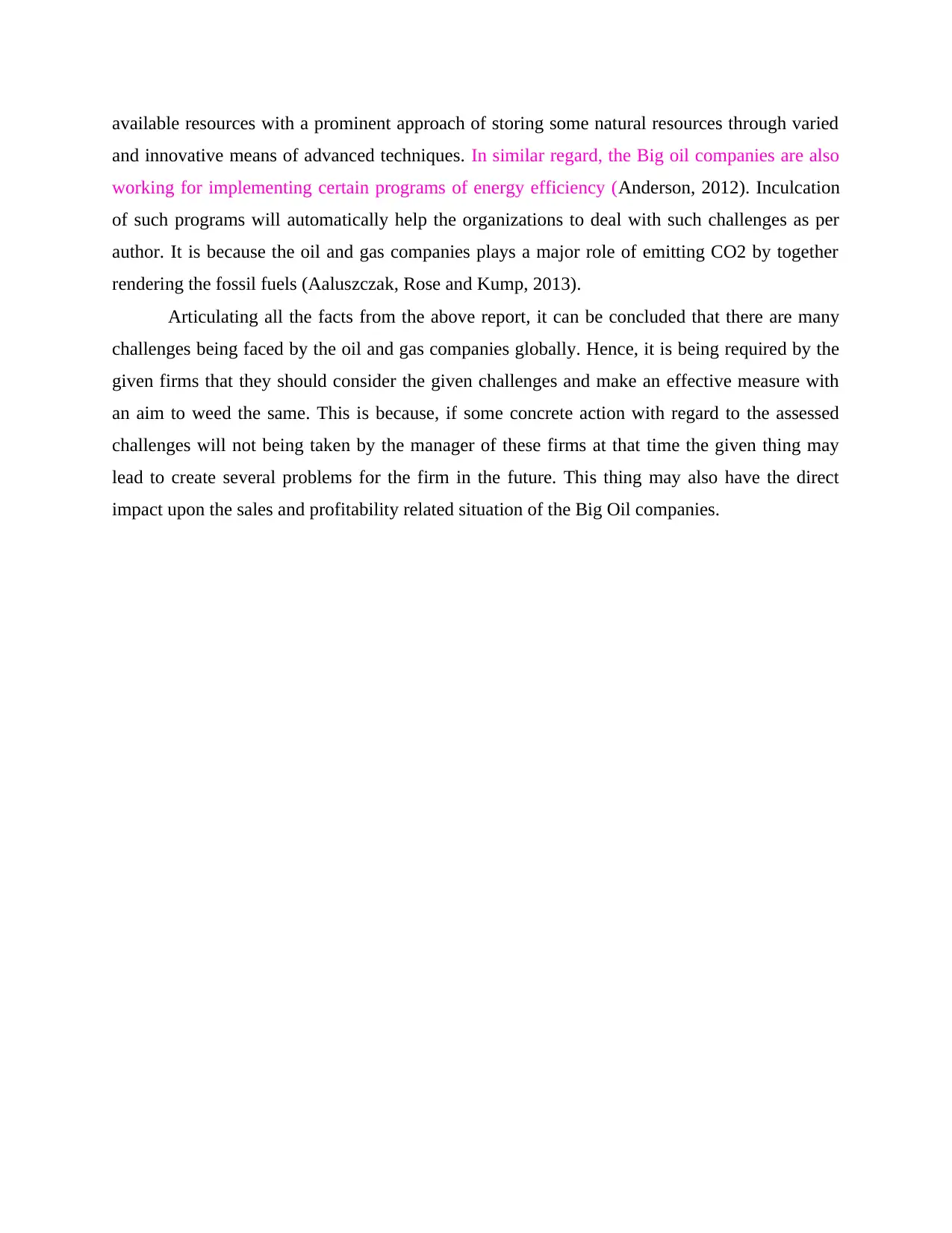
available resources with a prominent approach of storing some natural resources through varied
and innovative means of advanced techniques. In similar regard, the Big oil companies are also
working for implementing certain programs of energy efficiency (Anderson, 2012). Inculcation
of such programs will automatically help the organizations to deal with such challenges as per
author. It is because the oil and gas companies plays a major role of emitting CO2 by together
rendering the fossil fuels (Aaluszczak, Rose and Kump, 2013).
Articulating all the facts from the above report, it can be concluded that there are many
challenges being faced by the oil and gas companies globally. Hence, it is being required by the
given firms that they should consider the given challenges and make an effective measure with
an aim to weed the same. This is because, if some concrete action with regard to the assessed
challenges will not being taken by the manager of these firms at that time the given thing may
lead to create several problems for the firm in the future. This thing may also have the direct
impact upon the sales and profitability related situation of the Big Oil companies.
and innovative means of advanced techniques. In similar regard, the Big oil companies are also
working for implementing certain programs of energy efficiency (Anderson, 2012). Inculcation
of such programs will automatically help the organizations to deal with such challenges as per
author. It is because the oil and gas companies plays a major role of emitting CO2 by together
rendering the fossil fuels (Aaluszczak, Rose and Kump, 2013).
Articulating all the facts from the above report, it can be concluded that there are many
challenges being faced by the oil and gas companies globally. Hence, it is being required by the
given firms that they should consider the given challenges and make an effective measure with
an aim to weed the same. This is because, if some concrete action with regard to the assessed
challenges will not being taken by the manager of these firms at that time the given thing may
lead to create several problems for the firm in the future. This thing may also have the direct
impact upon the sales and profitability related situation of the Big Oil companies.
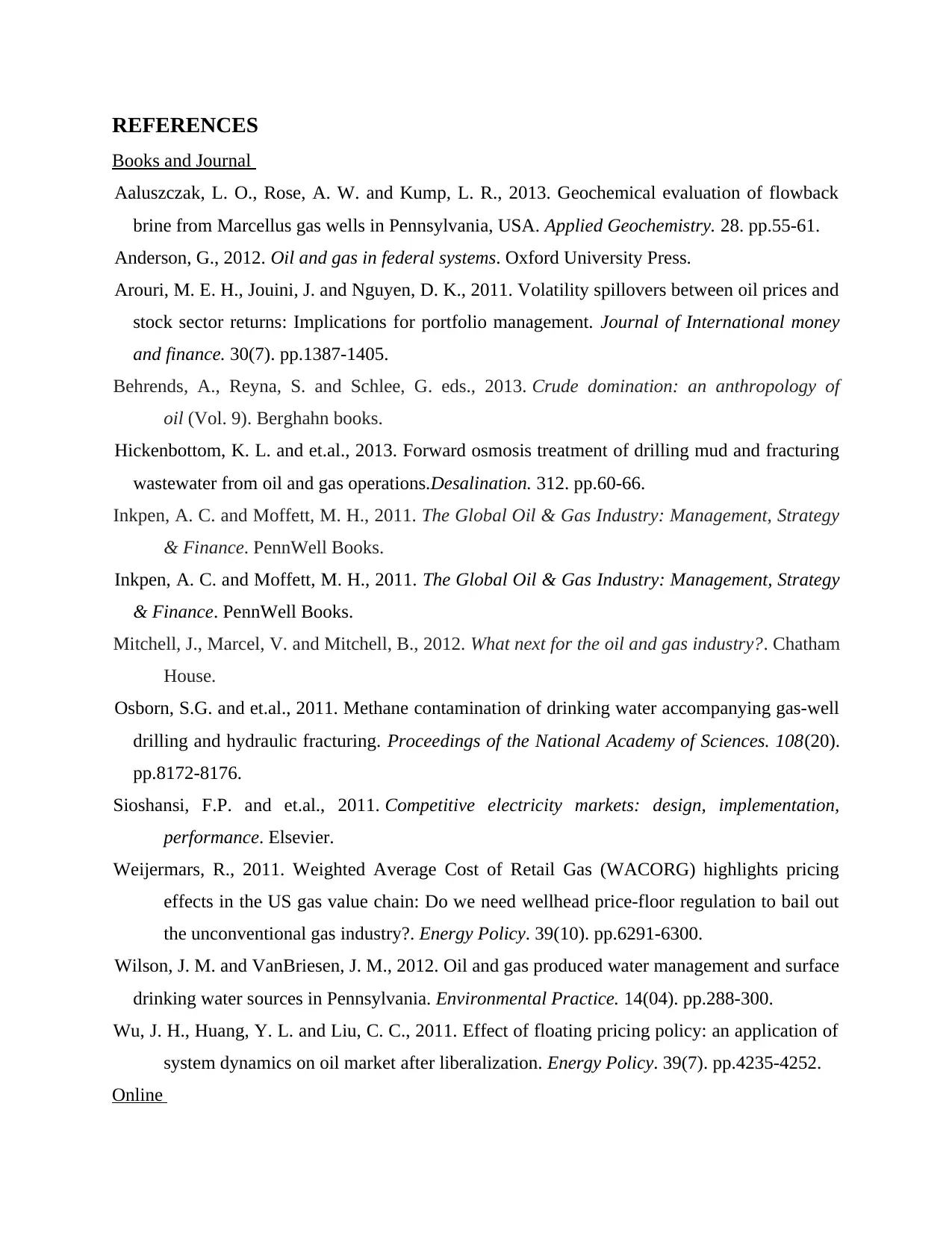
REFERENCES
Books and Journal
Aaluszczak, L. O., Rose, A. W. and Kump, L. R., 2013. Geochemical evaluation of flowback
brine from Marcellus gas wells in Pennsylvania, USA. Applied Geochemistry. 28. pp.55-61.
Anderson, G., 2012. Oil and gas in federal systems. Oxford University Press.
Arouri, M. E. H., Jouini, J. and Nguyen, D. K., 2011. Volatility spillovers between oil prices and
stock sector returns: Implications for portfolio management. Journal of International money
and finance. 30(7). pp.1387-1405.
Behrends, A., Reyna, S. and Schlee, G. eds., 2013. Crude domination: an anthropology of
oil (Vol. 9). Berghahn books.
Hickenbottom, K. L. and et.al., 2013. Forward osmosis treatment of drilling mud and fracturing
wastewater from oil and gas operations.Desalination. 312. pp.60-66.
Inkpen, A. C. and Moffett, M. H., 2011. The Global Oil & Gas Industry: Management, Strategy
& Finance. PennWell Books.
Inkpen, A. C. and Moffett, M. H., 2011. The Global Oil & Gas Industry: Management, Strategy
& Finance. PennWell Books.
Mitchell, J., Marcel, V. and Mitchell, B., 2012. What next for the oil and gas industry?. Chatham
House.
Osborn, S.G. and et.al., 2011. Methane contamination of drinking water accompanying gas-well
drilling and hydraulic fracturing. Proceedings of the National Academy of Sciences. 108(20).
pp.8172-8176.
Sioshansi, F.P. and et.al., 2011. Competitive electricity markets: design, implementation,
performance. Elsevier.
Weijermars, R., 2011. Weighted Average Cost of Retail Gas (WACORG) highlights pricing
effects in the US gas value chain: Do we need wellhead price-floor regulation to bail out
the unconventional gas industry?. Energy Policy. 39(10). pp.6291-6300.
Wilson, J. M. and VanBriesen, J. M., 2012. Oil and gas produced water management and surface
drinking water sources in Pennsylvania. Environmental Practice. 14(04). pp.288-300.
Wu, J. H., Huang, Y. L. and Liu, C. C., 2011. Effect of floating pricing policy: an application of
system dynamics on oil market after liberalization. Energy Policy. 39(7). pp.4235-4252.
Online
Books and Journal
Aaluszczak, L. O., Rose, A. W. and Kump, L. R., 2013. Geochemical evaluation of flowback
brine from Marcellus gas wells in Pennsylvania, USA. Applied Geochemistry. 28. pp.55-61.
Anderson, G., 2012. Oil and gas in federal systems. Oxford University Press.
Arouri, M. E. H., Jouini, J. and Nguyen, D. K., 2011. Volatility spillovers between oil prices and
stock sector returns: Implications for portfolio management. Journal of International money
and finance. 30(7). pp.1387-1405.
Behrends, A., Reyna, S. and Schlee, G. eds., 2013. Crude domination: an anthropology of
oil (Vol. 9). Berghahn books.
Hickenbottom, K. L. and et.al., 2013. Forward osmosis treatment of drilling mud and fracturing
wastewater from oil and gas operations.Desalination. 312. pp.60-66.
Inkpen, A. C. and Moffett, M. H., 2011. The Global Oil & Gas Industry: Management, Strategy
& Finance. PennWell Books.
Inkpen, A. C. and Moffett, M. H., 2011. The Global Oil & Gas Industry: Management, Strategy
& Finance. PennWell Books.
Mitchell, J., Marcel, V. and Mitchell, B., 2012. What next for the oil and gas industry?. Chatham
House.
Osborn, S.G. and et.al., 2011. Methane contamination of drinking water accompanying gas-well
drilling and hydraulic fracturing. Proceedings of the National Academy of Sciences. 108(20).
pp.8172-8176.
Sioshansi, F.P. and et.al., 2011. Competitive electricity markets: design, implementation,
performance. Elsevier.
Weijermars, R., 2011. Weighted Average Cost of Retail Gas (WACORG) highlights pricing
effects in the US gas value chain: Do we need wellhead price-floor regulation to bail out
the unconventional gas industry?. Energy Policy. 39(10). pp.6291-6300.
Wilson, J. M. and VanBriesen, J. M., 2012. Oil and gas produced water management and surface
drinking water sources in Pennsylvania. Environmental Practice. 14(04). pp.288-300.
Wu, J. H., Huang, Y. L. and Liu, C. C., 2011. Effect of floating pricing policy: an application of
system dynamics on oil market after liberalization. Energy Policy. 39(7). pp.4235-4252.
Online
⊘ This is a preview!⊘
Do you want full access?
Subscribe today to unlock all pages.

Trusted by 1+ million students worldwide

Cash Crunch Clouds Future for Oil Firms. 2016. [Online]. Available through:
<http://www.wsj.com/articles/cash-crunch-clouds-future-for-oil-firms-1445816429>.
[Accessed on 11th April 2016].
Dividend Cut Risk of The 6 Oil Super Majors. 2016. [Online]. Available through:
<http://www.suredividend.com/oil-super-majors/>. [Accessed on 11th April 2016].
<http://www.wsj.com/articles/cash-crunch-clouds-future-for-oil-firms-1445816429>.
[Accessed on 11th April 2016].
Dividend Cut Risk of The 6 Oil Super Majors. 2016. [Online]. Available through:
<http://www.suredividend.com/oil-super-majors/>. [Accessed on 11th April 2016].
1 out of 10
Related Documents
Your All-in-One AI-Powered Toolkit for Academic Success.
+13062052269
info@desklib.com
Available 24*7 on WhatsApp / Email
![[object Object]](/_next/static/media/star-bottom.7253800d.svg)
Unlock your academic potential
Copyright © 2020–2025 A2Z Services. All Rights Reserved. Developed and managed by ZUCOL.





